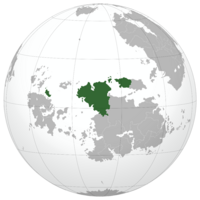Public Utilities Commission (Cartadania)
This article or section is in the process of an expansion or major restructuring. You are welcome to assist in its construction by editing it as well. If this article or section has not been edited in several days, please remove this template. If you are the editor who added this template and you are actively editing, please be sure to replace this template with {{in use}} during the active editing session. Click on the link for template parameters to use.
This article was last edited by Insui (talk | contribs) 19 months ago. (Update timer) |
 Coat of Arms of Cartadania | |
 Headquarters in Alahuela adjacent the Department of Commerce | |
| Commission overview | |
|---|---|
| Formed | 1 July 1913 |
| Jurisdiction | Cartadania |
| Headquarters | 1300 State Street, Tiradentes, Alahuela |
| Annual budget | $ 1.6 billion (2019) |
| Commission executive |
|
| Parent department | DEMR |
| Website | Official Website |
The Cartadanian Public Utilities Commission (CPUC or PUC) is a regulatory agency that regulates privately owned public utilities in Cartadania, including telecommunications and water companies (electricity and natural gas are regulated by DEMR). In addition, the CPUC regulates common carriers, including household goods movers, passenger transportation companies such as limousine services, and rail crossing safety within the federal capital. The CPUC has headquarters in the Tiradentes district of Alahuela, and field offices throughout the country.
History
The telephone networks in Cartadania grew from local and regional telephone systems. As cities grew, so did the number of active telephone systems and associated service areas which were interconnected via tie trunks. It was the responsibility of each local administration to devise telephone numbering plans that accommodated the local requirements and growth. As a result, the Cartadanian telephone service industry developed into an unorganized system of many differing local numbering systems. The diversity impeded the efficient operation and interconnection of exchanges into a nationwide system for long-distance telephone communication. As a result, the Public Utilities Commission was established in 1913 to regulate the usage of this system and to unify its procedures. The commission divided the country into numbering plan areas, each assigned a unique three-digit code, typically referred to as an area code. This allowed for the entire country to unite under a single system and allowed Cartadanians in rural areas at the fringe of the country to call all the way to the capital, establishing a new precedent in telecommunications for the country that has only grown with time.
In 1945, the Department of Water Resources was dissolved and its functions transferred to DEMR, which subsequently alotted them to PUC, thus, it also came to regulate water resources. This is typically restricted to oversight of state utility commissions and Alahuela's water system, but the agency does also partially set regulations for territorial water usage as well.
Structure
Telecommunications
The telephony system employs an extensive system of modern network elements such as digital telephone exchanges, mobile switching centers, media gateways and signaling gateways at the core, interconnected by a wide variety of transmission systems using fiber-optics or Microwave radio relay networks. The access network, which connects the subscriber to the core, is highly diversified with different copper-pair, optic-fiber, and wireless technologies. The fixed-line telecommunications market is dominated by Axiom Communications and Alfa Telecom, while the mobile phone market in Cartadania is dominated by 3 main cellular operators: Axiom Communications, Alô, and Claro.
Numbering plan
 Cartadania in Sarpedon | |
| Location | |
|---|---|
| Country | Cartadania |
| Continent | Sarpedon |
| Regulator | CPUC |
| Type | Closed |
| NSN length | 10 |
| Typical format | +10 NXX NXX-XXXX |
| Access codes | |
| Country calling code | 10 |
| International call prefix | 00 |
| Trunk prefix | none |
Cartadania uses a ten-digit closed numbering plan, where the first three digits denote a numbering plan area or area code, the second three denote the central office code or exchange code, and the final four are a unique set for each area code, spanning from 0000 to 9999, referred to as the line number or station code. Permissible numbers exclude easily recognizable codes N11, used for special services, like EMS and utility departments.